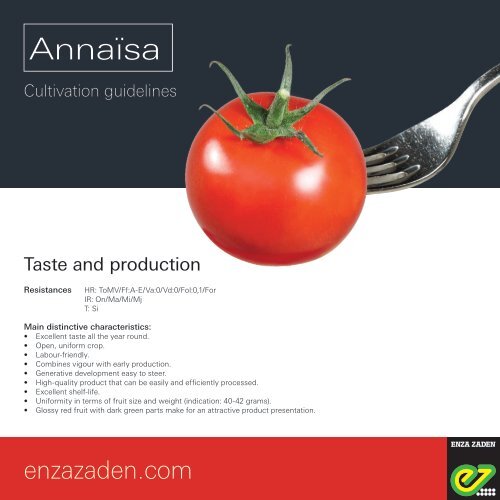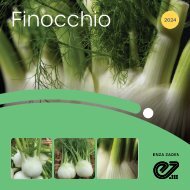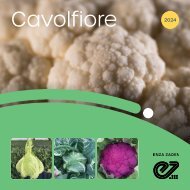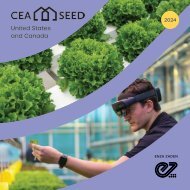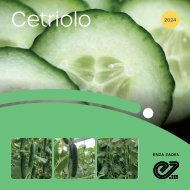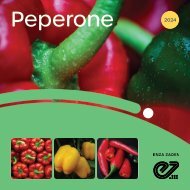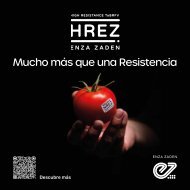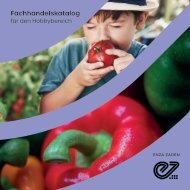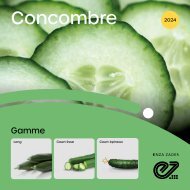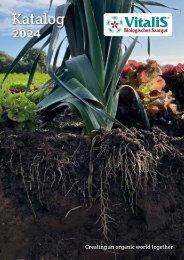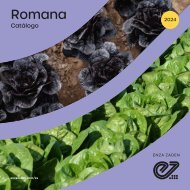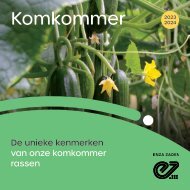Guidelines Annaïsa 2017
Create successful ePaper yourself
Turn your PDF publications into a flip-book with our unique Google optimized e-Paper software.
<strong>Annaïsa</strong><br />
Cultivation guidelines<br />
Taste and production<br />
Resistances<br />
HR: ToMV/Ff:A-E/Va:0/Vd:0/Fol:0,1/For<br />
IR: On/Ma/Mi/Mj<br />
T: Si<br />
Main distinctive characteristics:<br />
• Excellent taste all the year round.<br />
• Open, uniform crop.<br />
• Labour-friendly.<br />
• Combines vigour with early production.<br />
• Generative development easy to steer.<br />
• High-quality product that can be easily and efficiently processed.<br />
• Excellent shelf-life.<br />
• Uniformity in terms of fruit size and weight (indication: 40-42 grams).<br />
• Glossy red fruit with dark green parts make for an attractive product presentation.<br />
enzazaden.com
Characteristics<br />
<strong>Annaïsa</strong> produces a strong, uniformly growing, bushy crop with large leaves. It has<br />
good endurance and regeneration capacity and it is fairly easy to steer its generative<br />
development.<br />
The plants look robust, but their heads are fairly slender and generative. They will<br />
become heavier as they grow, especially those planted between 1 June and<br />
1 September. You may well have to remove a leaf from the top of the plant during<br />
certain parts of the year, certainly from the time of flowering of the 3rd or 4th cluster<br />
up to the time when it is evident from the crop’s development that it is no longer<br />
necessary.<br />
Important characteristics are the product’s presentation, external quality and, above<br />
all, its excellent taste. <strong>Annaïsa</strong> has a high Brix value and wonderful taste early in the<br />
season already – a major advantage over reference varieties. The tomatoes are uniform<br />
in terms of size, with a year-round average weight of around 40 to 42 grams. The fruits<br />
have a striking glossy, bright red colour with attractive green parts.<br />
Another major advantage is the flat truss shape, making it easy to harvest, process<br />
and pack the trusses.<br />
Rootstock and propagation<br />
<strong>Annaïsa</strong> quickly grows into sturdy plants. A little elongation may occur during<br />
propagation in trays, so it is important to graft and prick out the young plants on time.<br />
In principle, we advise you to use a vigorous rootstock, though that will of course<br />
depend on your cultivation system, type of greenhouse, etc.<br />
As we propagate our plants in a fairly light environment we advise you to halve the first<br />
leaf after grafting, to avoid the risk of strong vegetative development. It is important to<br />
ensure adequate generative growth, especially during propagation periods before<br />
1 September.<br />
Plants will usually have to be transplanted to around 2.5 plants/m². Preferably increase<br />
the plant distance to 2.9 to 3.2 plants/m² when you pinch out the first shoot. This will<br />
of course depend on the planting date and your lighting capabilities.<br />
Start of the season<br />
We advise that you start with a slab EC of 3.8–4.0 mS/cm. In practice, conditions are<br />
sometimes controlled for 3 to 6 days after the planting, but we advise you not to do<br />
that. Conditions immediately after planting will often be warm and light; root growth<br />
and water absorption must not be hindered in any way during this phase.<br />
Climate<br />
Ensure high 24-hour temperatures, if possible with a day/night difference of 5 ˚C to<br />
7 ˚C, from the second day after planting to promote generative development and the<br />
formation of well-balanced plants. This may be difficult to realise in crops planted<br />
between 1 April and mid-September, when surplus light may restrict your options.<br />
This will also be the case with crops planted after mid-September, but more important<br />
with these crops will be to ensure humidity is adequately controlled. <strong>Annaïsa</strong> needs<br />
an airy climate promoting an active crop.<br />
We tend to regard the thicker stems and long, large leaves of plants planted after<br />
20 September as “vegetative”. In the case of <strong>Annaïsa</strong> we advise you to accept the<br />
large size of your plants around the time of the formation of trusses 5 or 6 (depending<br />
on the planting date) and to focus solely on the quality of the clusters. You may well<br />
have to lower the 24-hour temperatures earlier than you’d think. If you continue with<br />
high 24-hour temperatures for too long in the hope of obtaining “slender” plants<br />
you will often end up with weak trusses of tomatoes with a (too) low weight in late<br />
December and January.<br />
It is important with this variety to ensure an airy climate and an active crop, to<br />
gradually raise the temperature to the day value and to ensure sufficient humidity<br />
control (but without having to take extreme measures). You must – literally – invest<br />
enough energy in it.<br />
An early morning temperature of 17 ˚C-18 ˚C (+0.5 ˚C light) will usually suffice. If the<br />
crop’s temperature is too high early in the morning you will have to vent close to<br />
the heating temperature. Venting, and a climate promoting an active crop are your<br />
most important tools in the first cultivation phase. But don’t overdo things, because<br />
too much venting causing the greenhouse temperature to drop too much will<br />
involve a risk of cold heads and leaf margins. Invest sufficient energy in heating your<br />
greenhouse to promote active plant development. Raise the temperature slowly to the<br />
daytime value on days with low outdoor light intensities.
A “morning dip” may in some periods be a good way of boosting the quality of the<br />
clusters. Lowering the temperature to 16 ˚C for 1.5 to 3 hours in the early morning has<br />
been found to lead to good results in practice. Vent close to the heating temperature in<br />
the morning to keep the atmosphere cool and airy. You should reach the set daytime<br />
temperature between around 11 a.m. and 1 p.m., depending on the time of year and<br />
the outdoor light intensity.<br />
Ensure a “normal” afternoon temperature, without extremes, especially during the<br />
first months of the crop’s development. Aim for a maximum of 25 ˚C combined with a<br />
venting temperature of between 21 ˚C and 24 ˚C. This will of course again depend on<br />
light intensities and outdoor conditions.<br />
We advise you not to drop below 15 ˚C in the evening on cloudy (warm) days and to<br />
ensure a temperature of at least 16 ˚C on bright (cold) days. <strong>Annaïsa</strong> does not need<br />
extreme or very low evening temperatures, but it does require a higher temperature<br />
during the day.<br />
Don’t allow the relative humidity to rise too much in the daytime and keep your crop<br />
active at all times.<br />
It’s relatively easy to promote generative development in <strong>Annaïsa</strong>. The crops do not<br />
need extreme climate conditions to ensure growth, fruit set, large plants and tomatoes<br />
and a well-balanced plant. Always try to aim for high-quality tomatoes in an airy,<br />
strong crop that looks robust.<br />
Harvesting and supporting the vines<br />
<strong>Annaïsa</strong> produces large clusters of suffi cient fl owers that set fruit quickly. We advise<br />
you to stick to a maximum of 9 tomatoes/truss to ensure uniform production at a<br />
satisfactory rate and tomatoes of good quality. You could consider 10 tomatoes/truss<br />
in some weeks, when the fl owering rate exceeds 1,2 clusters/week. We advise you to<br />
stick to 8 tomatoes/truss in the period from around week 48 until week 3 to 4; this will<br />
ensure sufficient production during the short, dark days of December and January.<br />
<strong>Annaïsa</strong> produces firm, nicely curving vines. We advise you to use truss clips for the<br />
first 7 to 8 trusses formed or growing in periods of low light intensities.<br />
Fertigation<br />
In principle, stick to the recommended standard doses of the various nutrient<br />
elements; they seem to work best for this variety. What may require a little extra<br />
attention are the magnesium and potassium levels. Something that you should bear<br />
in mind is that <strong>Annaïsa</strong> appears to consume more magnesium than other varieties<br />
during the first months of the crop’s development, up to the harvesting of the second<br />
truss. We advise you to give your crop 1 to 2 mmol/l extra Mg in that period. <strong>Annaïsa</strong><br />
is also characterised by easy uptake of and a high demand for potassium.<br />
In spite of the large leaves, the plants are fairly open, and the fairly horizontal position<br />
of the leaves makes it easy to work in the crop. <strong>Annaïsa</strong> easily forms extra stems.<br />
At a light intensity of around 12,500 Lux (± 135-140 micromol/m²/s PAR) the optimum<br />
stem density in winter will be between 2.8 and 3.2/m². At intensities of 14,000 Lux or<br />
higher the optimum maximum density will be around 3.75/m².<br />
Depending on your specifi c requirements, planting dates and type of greenhouse, the<br />
maximum stem density will be between 3.75 and 4.2/m². Try to increase to maximum<br />
stem density between weeks 3 and 4.
enzazaden.com<br />
Enza Zaden<br />
P.O. Box 7 | 1600 AA Enkhuizen | The Netherlands<br />
Haling 1E | 1602 DB Enkhuizen | The Netherlands<br />
Tel +31 (0)228 35 01 00 | fax +31 (0)228 35 02 00<br />
info@enzazaden.nl | www.enzazaden.com<br />
Descriptions, recommendations and illustrations in brochures and leaflets shall correspond as closely as possible to tests and practical<br />
experience and are subject to typographical and/or printing errors. This information shall be provided to assist professional growers and<br />
users, whereby variable local conditions must be taken into account. Under no circumstances shall Enza Zaden accept liability based on such<br />
information for deviating results in the cultivated product. © Enza Zaden | Enkhuizen | the Netherlands | July <strong>2017</strong>


